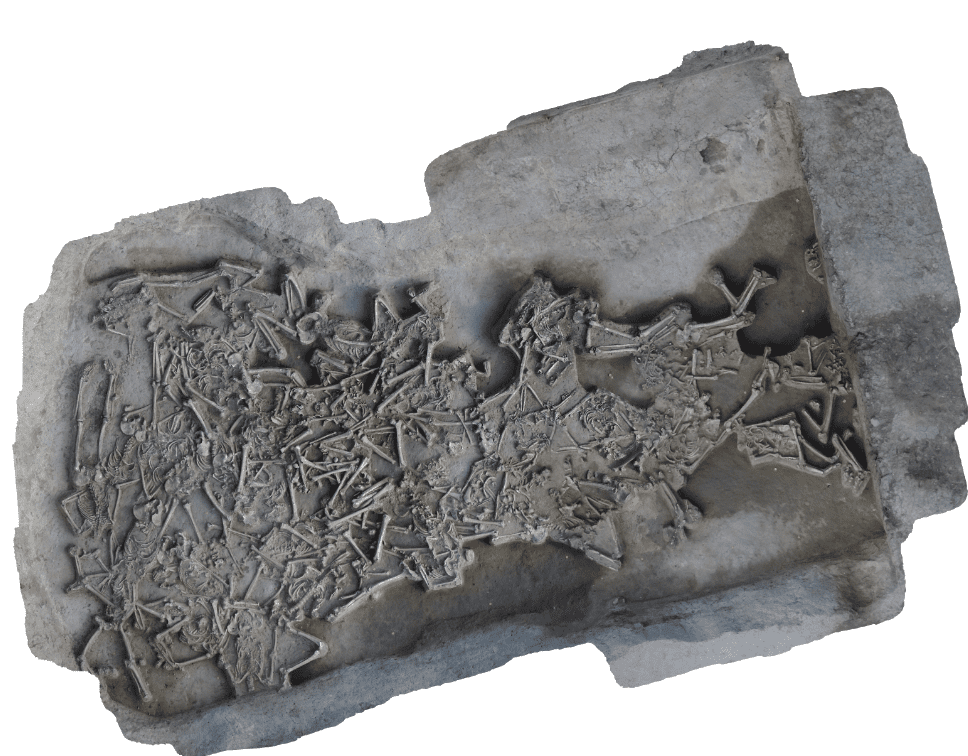Dozens of headless skeletons were discovered at a prehistoric pit in Slovakia last year, leading archeologists to ask a simple question: what on Earth went on here? Now, researchers are starting to unveil the story behind this gruesome site – and things might not be as straightforward as they first appear.
In 2022, the remains of 38 people were found in a ditch near the small Slovakian town of Vráble. All of the skeletons were missing their skulls, including their lower jawbones, with the exception of a single young child. The site dates to somewhere between 5250 to 4950 BCE and is considered one the largest settlement sites of the Early Neolithic in Central Europe.
Within a ditch measuring approximately 15 meters square (16 feet square), the skeletons were found in a jumbled mess, with their bones now overlapping each other as if the bodies were carelessly thrown in the pit or rolled on top of one another.
Not only does this make for a shocking sight to behold, but it also makes the process of analyzing the skeletons extremely fiddly.
“We assumed to find more human skeletons, but this exceeded all imaginations,” Professor Dr Martin Furholt, an expert on the European Neolithic and Early Bronze Age who led the project, said in a statement.
A 3D-scan of the excavation site. Image credit: © Dr. Till Kühl, Institute for Pre- and Protohistoric Archaeology/Kiel University
“In mass graves with an unclear positioning, the identification of an individual is usually based on the skull, so for us this year’s find represents a particularly challenging excavation situation,” he added.
The discovery sparked many questions: was this a bloody massacre? Or were these people victims of disease? How and why were the heads removed? Was this a single event or a series of burials over generations? Despite the complexity of the site, the researchers are starting to uncover some clues.
At first glance, you might assume that this grisly pit is evidence of a violent bloodbath and bitter rivalries. Perhaps two rival communities clashed and these were the unfortunate losers of the conflict. However, the researchers’ preliminary work suggests that something more peculiar occurred here.
“Several individual bones out of anatomical position suggest that the temporal sequence might have been more complex. It is possible that already-skeletonised bodies were pushed into the middle of the trench to make room for new ones,” explains Dr Katharina Fuchs, an anthropologist at Kiel University.
Another shot of some of the remains, showing their lack of heads. Image credit: © Dr. Till Kühl, Institute for Pre- and Protohistoric Archaeology/Kiel University
“In some skeletons, the first cervical vertebra is preserved, indicating careful removal of the head rather than beheading in the violent, ruthless sense – but these are all very preliminary observations that remain to be confirmed with further investigation,” she noted.
The team hopes to carry out further archaeological investigations, DNA analysis, radiocarbon dating, and stable isotope analysis. From this, they will be able to gain insights such as whether they were buried together and if they were related, as well as if they were locals or came from far away. It could also reveal the presence of disease or further injuries.
Armed with that information, the mystery of this grave might be solved.
Source Link: A Massacre Or Something Stranger? 37 Headless Skeletons Raise Questions
